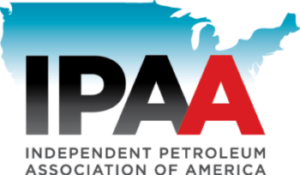Apr 26, 2011 America’s Oil, Natural Gas Producers Targeted for Tax Hikes
Independent Producers – Not ‘Big Oil’ – lead America’s oil and natural gas development – Drill 95% of Wells in the United States
WASHINGTON – Policymakers in Washington are, once again, talking about raising taxes on U.S. producers of oil and natural gas – tax increases that have been proposed the last three years, and have been soundly rejected. Today, Barry Russell, president and CEO of the Independent Petroleum Association of America (IPAA), released the following statement about how these punitive tax hikes would devastate America’s independent producers:
“Contrary to popular belief, these tax proposals do not target “Big Oil,” but instead go after 18,000American independent oil and natural gas producers, who on average employ only 12 workers. American production activities are dominated by these independent producers who drill 95 percent of the nation’s natural gas and oil wells, accounting for 67% of total U.S. natural gas and oil production. America’s independents are dedicated to finding and producing America’s energy resources, creating jobs, generating revenues and supplying reliable and affordable energy all across the United States.
“In fact, a recent I H S Global Insight study showed that independent oil and natural gas producers operating onshore in the U.S. accounted for nearly four million American jobs in 2010, a number that represents more than three percent of the total U.S. workforce. Very few industries have the potential to create as many better than average paying jobs as quickly and effectively as we do.
“The study also projects that onshore independents will return more than $930 billion to state, local and federal governments in the form of taxes, rents and royalties over the next 10 years – all driven by a forecast that predicts an ever-expanding role for U.S. independents in developing more onshore wells, and delivering greater volumes of reliable and affordable oil and natural gas to American consumers.
“However, these positive forecasts cannot be realized if the government raises taxes on these producers, which will consequently reduce capital investments. Historically, independent producers have reinvested as much as 150 percent of their American cash flow back into new American production. Drilling costs are a key component of capital expenditure budgets for independent producers. Without the ability to expense these ordinary and necessary business costs, an independent would have to reduce its drilling budget by 20 to 35 percent almost immediately. In addition, all mineral resources are allowed to use percentage depletion as a way to reflect the decreasing value of the resource as it is produced. For oil and natural gas, only independent producers and royalty owners are allowed percentage depletion and only on U.S. production, not ‘Big Oil’.
“Increasing taxes on independent producers, who supply the vast majority of oil and natural gas in America, will reduce capital investment in the industry, and it will result in fewer jobs, less revenue to American governments, hurt American retirees, whose mutual funds, pension plans and Individual Retirement Accounts are invested in publicly traded oil and gas companies, and harm American energy security.
“Policymakers must recognize the important role that independent energy producers can play in fueling the short-term recovery and long-term revitalization of America’s struggling economy. Unfortunately, endorsing a series of shortsighted tax changes will move this country in the opposite direction, and will result in fewer American jobs, less government revenue, and a tightening of our already dangerous dependence on foreign, unstable energy. IPAA will continue to work directly with those in Congress – both Democrats and Republicans – who recognize the value that independent American energy producers can deliver if given the opportunity to do it.”
TAX FACTS
- Drilling costs are a key component of capital expenditure budgets for independent producers. Without the ability to expense these ordinary and necessary business costs, an independent would have to reduce its drilling budget by 20 to 35 percent almost immediately.
- All mineral resources are allowed to use percentage depletion as a way to reflect the decreasing value of the resource as it is produced. For oil and natural gas, only independent producers and royalty owners are allowed percentage depletion and only on U.S. production.
- Further, percentage depletion is limited to the first 1,000 barrels/day of production (along with other limits) thereby making it a provision that is largely used by small business producers and royalty owners.
- Small business producers are the primary operators of America’s marginal oil wells (19 percent of U.S. production) and marginal natural gas wells (12 percent of U.S. production).
- Tax provisions targeted for repeal are ordinary and necessary business expenditures that have been recognized in the federal tax code since its beginning in 1913 (drilling cost expensing) or shortly thereafter, such as percentage depletion in 1926. These provisions are not tax subsidies.
I H S GLOBAL INSIGHT FINDINGS (ONSHORE OIL, GAS PRODUCERS)
- JOBS: In 2010, almost 4 million direct, indirect and induced jobs were supported by the independents’ business ecosystem, accounting for over 3% of all US jobs.
- THE ECONOMY: The independents’ business ecosystem contributed $579 billion (4.0%) of US GDP in 2010.
- TAXES: In 2010, onshore independents’ (upstream) activity generated $30.7 billion in income taxes (federal and state), sales tax and excise taxes. Additionally, onshore independents’ upstream activity led to $38.4 billion in corporate taxes, severance taxes and federal royalty payments in 2010. The entire direct/indirect/induced ecosystem of the onshore independents generated $131 billion of federal and state taxes in 2010, a figure that will increase to $189 billion by 2020.
- ENERGY CONTRIBUTION: This study (combined with an earlier, similar IHS study looking at independents in the offshore) means that independents – onshore and offshore – collectively produce 54% of domestic oil and 85% of America’s natural gas, accounting for 67% of total U.S. production (oil and natural gas).
- Independents share of production and investment in the United States has been rising steadily over the last five years, both in liquids and natural gas. Currently, independents onshore account for 65% of the total natural gas production and close to 45% of the total onshore oil production in the United States. Over the next ten years these figures are expected to continue to increase as shale plays ramp up.”
- [Today] it takes fewer wells to produce the same amount as before. For example, prior to 2008, more than 31,000 annual new gas wells were required to sustain 58 BCF/d of gas production; now it is possible to produce almost 63 BCF/d with the drilling of only 19,000 new gas wells per year. Of the 27,409 wells drilled in 2010, independents drilled 26,030 wells, while other companies drilled 1,379 wells.
- The onshore independents’ direct upstream value of output is thus expected to grow from $263 billion today to $351 billion in 2020 … Total upstream jobs are expected to increase from 2.1 million in 2010 to 2.6 million in 2020.”
READ MORE
- Fact Sheet:An Introduction to U.S. Oil and Gas Industry Taxation
- Fact Sheet: Increasing Taxes on America’s Independent Natural Gas and Oil Producers – Bad Idea
- Friday Fact Check 2/11/11:White House, American Oil, Natural Gas Foes on Capitol Hill Ready Massive, Job-Crushing Tax Hikes








